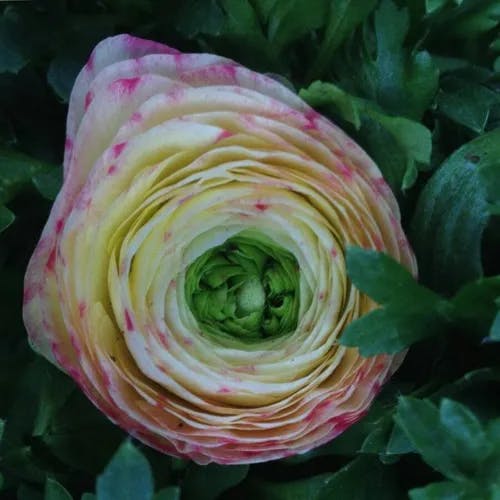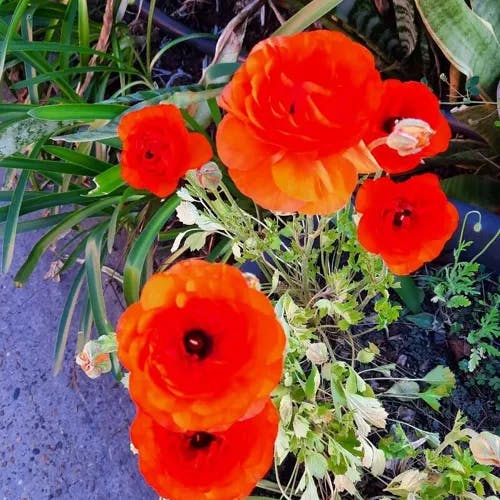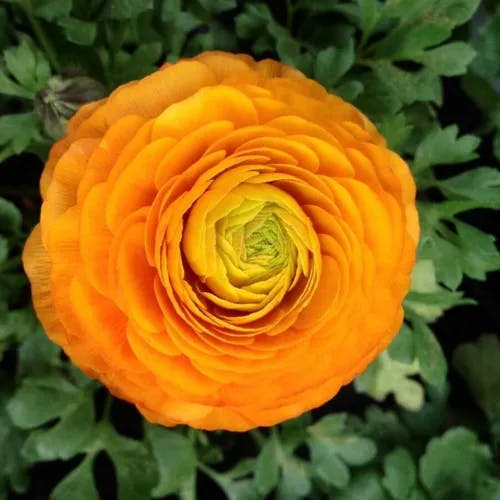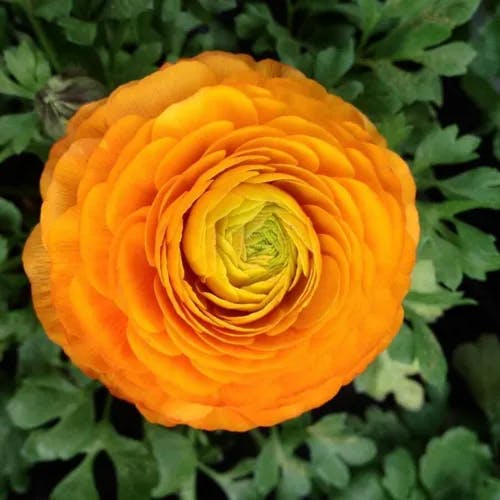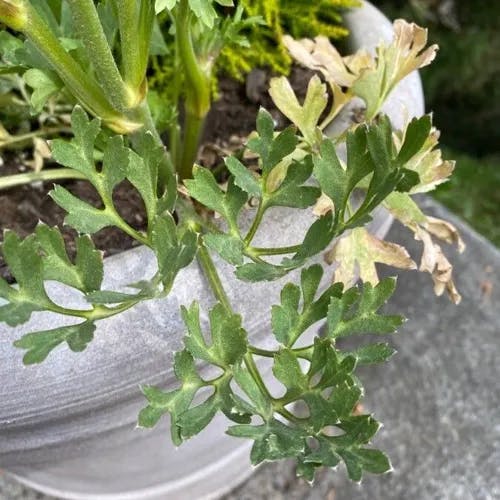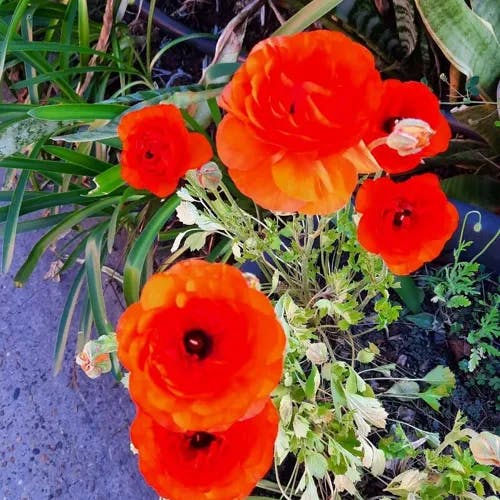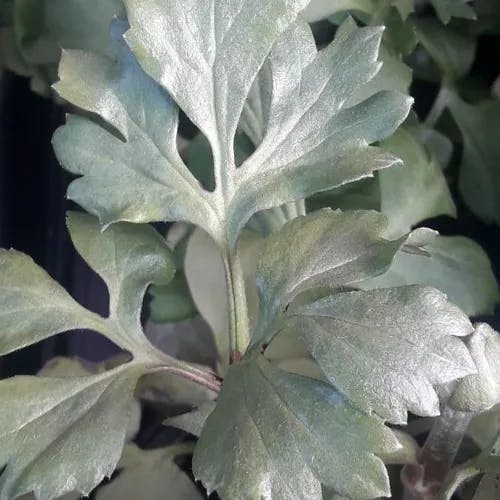Ranunculus asiaticus, commonly known as the Persian buttercup, is a perennial plant species in the Ranunculaceae family. It is native to the eastern Mediterranean region, including parts of southwestern Asia and southeastern Europe. The plant typically grows to a height of 45 cm and a width of 30 cm. It has a tuberous root system, which allows it to survive in dry climates. The leaves are basal, divided into three lobes, and have a glossy, dark green color. The flowers of Ranunculus asiaticus are its most striking feature. They are large, usually 3-5 cm in diameter, and come in a variety of colors including red, pink, yellow, and white. The flowers have a double form, meaning they have multiple layers of petals, giving them a full, lush appearance. The fruit of the Persian buttercup is an achene, a type of dry fruit that does not split open at maturity. Each flower can produce multiple achenes, which are small and brown in color. In terms of symbolism, the Persian buttercup often represents charm and attractiveness. It is a popular choice for bouquets and floral arrangements due to its vibrant colors and long-lasting blooms. Ranunculus asiaticus is relatively easy to grow, preferring full sun and well-drained soil. It is hardy to USDA zones 8-10, meaning it can tolerate mild winters. However, it is not frost-tolerant and may require protection in colder climates. There are many cultivars of Ranunculus asiaticus available, offering a wider range of flower colors and forms. Some popular varieties include 'Bloomingdale', 'Elegance', and 'Mache'. In conclusion, Ranunculus asiaticus is a versatile and attractive plant species, known for its vibrant, double-form flowers and ease of cultivation. Its wide range of colors and forms make it a popular choice for both gardeners and florists.
Persian Buttercup
- Common name
- Persian buttercup,Asiatic Buttercup
- Scientific name
- Ranunculus asiaticus
Basic Information
- Ranunculaceae Family Ranunculus Genus Persian Buttercup Species
- Ranunculaceae > Ranunculus > Ranunculus asiaticus
- 83%
- The Completeness of This Encyclopedia
Please help us complete the encyclopedia, Terrarium is a encyclopedia service to be completed with everyone in the world. Currently, this page is 83% complete. For more information on how to contribute, please click here.
- Flower
- Forb/herb
- Perennial
- Height
- 45cm ~ 45cm
- Flower Color
- Leaf Color
- Anthesis
- spring
- Sunlight Exposure
Full Sun Long hours of sunlight from morning to afternoon Partial Shade A location in the shade of a tree or where either the morning or afternoon is shaded Full Shade A place where there is no direct sunlight
- Full Sun
- Hardiness Zones
This is an indicator to know to which zone each plant can winter. Knowing the zone of each plant gives you an idea of the cold temperature resistance when grown in the ground without a roof. 2: -42.7 to -40.0 3: -39.9 to -34.4 4: -34.3 to -28.9 5: -28.8 to -23.3 6: -23.2 to -17.8 7: -17.7 to -12.2 8: -12.1 to -6.7 9: -6.6 to -1.1 10: -1.0 to 4.4 11: 4.5 to 10.0
- 8
- Cold resistance
- Fair
- Heat resistance
- Fair
- Habitat of origin
- Turkey, Iran
- Growth Rate
- Normal
What is Persian Buttercup (Ranunculus asiaticus)?
What is Persian Buttercup (Ranunculus asiaticus)
Flower meaning
Ranunculus asiaticus, commonly known as the Persian buttercup, carries several meanings in the language of flowers in America. The most common interpretations include charm, attractiveness, and radiance. For instance, the charm associated with the Persian buttercup is often linked to its vibrant colors and delicate petals, symbolizing a captivating and irresistible personality. In addition, it is also considered a birth flower for the month of April, specifically representing those born on April 27th. Please note that the language of flowers can vary greatly depending on cultural and personal interpretations.
Calendar of Persian Buttercup (Ranunculus asiaticus)
Calendar
Ranunculus asiaticus, also known as Persian buttercup, typically blooms in the United States from late spring to early summer. The flowers are at their best in May and June. The blooming period can last for up to six weeks, depending on the growing conditions. To extend the blooming period, it is recommended to plant the bulbs in a location with full sun and well-drained soil. Regular watering, without overwatering, can also help prolong the blooming period. Deadheading, or removing spent flowers, can encourage the plant to produce more blooms. Please note that the exact timing of flowering can vary depending on the specific location and weather conditions. For more detailed information, please refer to reliable horticultural resources or consult with a local extension service.
How to grow Persian Buttercup (Ranunculus asiaticus)
Watering
Ranunculus asiaticus, also known as Persian buttercup, requires careful watering to thrive. The soil should be kept moderately moist, but not waterlogged. During the growing season, from spring to early summer, water the plant once a week. Approximately 1 inch of water should be sufficient, but this can vary depending on the soil type and climate. In hotter climates, the plant may require more frequent watering. During the dormant period, in late summer and fall, reduce watering to once every two weeks. The soil should be allowed to dry out between waterings to prevent root rot. In winter, water sparingly, only when the soil is dry to the touch. Overwatering can lead to fungal diseases, so it's important to monitor soil moisture levels regularly. Remember, the goal is to maintain a balance between keeping the soil moist and avoiding waterlogging.
Soil and Fertilizer
Ranunculus asiaticus, also known as Persian buttercup, thrives in well-drained soil with a pH range of 6.0 to 7.0. The soil should be rich in organic matter, which can be achieved by adding compost or well-rotted manure. Fertilizer application should be done in early spring, at the onset of growth. A balanced fertilizer, such as a 10-10-10 (N-P-K) formulation, is recommended. Apply the fertilizer at a rate of 1 pound per 100 square feet of garden area. Fertilizer application should be repeated every 4 to 6 weeks during the growing season. Avoid over-fertilization as it can lead to excessive foliage growth at the expense of flower production. Maintaining the soil's moisture level is crucial, but avoid waterlogging as it can lead to root rot. Regular soil testing can help maintain optimal soil conditions for Ranunculus asiaticus.
Sunlight and Place
Ranunculus asiaticus, also known as the Persian buttercup, thrives in full sun exposure. It requires at least six hours of direct sunlight per day for optimal growth and blooming. The plant is tolerant to heat but prefers cooler temperatures for its growth phase. The optimum temperature range for this species is between 60°F and 75°F. During the summer, it's crucial to provide adequate water to compensate for the increased evaporation due to heat. However, overwatering should be avoided as it can lead to root rot. In winter, the plant enters a dormant phase and can tolerate temperatures as low as 28°F. It's advisable to mulch around the plant to protect the roots from freezing temperatures. Placement of the plant should be in a location that receives ample sunlight but is protected from harsh afternoon sun. The plant's strength in sunlight is high, but it can suffer from sunburn if exposed to intense midday sun.
Advanced Information of Persian Buttercup (Ranunculus asiaticus)
Pruning
Ranunculus asiaticus, also known as Persian buttercup, requires minimal pruning. Pruning is necessary to remove spent flowers, known as deadheading, which encourages the plant to produce more blooms. The best time to prune is during the flowering season, typically in spring or early summer. To prune, use clean, sharp shears to cut back the flower stem to the base of the plant. After pruning, it's important to clean up any plant debris to prevent the spread of disease. In the fall, after the plant has finished blooming and the foliage has died back, cut the plant back to ground level. This helps to prepare the plant for winter dormancy and promotes healthy growth in the next growing season. Remember, over-pruning can stress the plant, so only remove what's necessary.
Planting and Harvest
Ranunculus asiaticus, also known as Persian buttercup, is best suited for pot cultivation due to its compact growth habit. Choose a pot with good drainage and fill it with a well-draining potting mix, such as a blend of peat moss, perlite, and compost. Plant the tubers 2 inches deep and 4 to 6 inches apart, with the claw-like part facing downwards. Water thoroughly after planting, then keep the soil slightly moist but not waterlogged. For repotting, do so in the fall, carefully lifting the tubers and replanting them in fresh potting mix. Mishowing, or incorrect positioning, can be corrected by gently repositioning the tuber. Ensure the plant receives full sun to partial shade, and feed with a balanced fertilizer every two weeks during the growing season. Remember, Persian buttercups are frost-sensitive, so bring the pot indoors during colder months.
Propagation
Ranunculus asiaticus, also known as Persian buttercup, is propagated primarily through tuber division and seed sowing. For tuber division, dig up the plant after it has finished flowering and the foliage has died back. Carefully divide the tubers, ensuring each piece has at least one eye. Replant immediately in well-draining soil. Seed sowing is best done in late winter or early spring. Soak the seeds in warm water for 24 hours before sowing. Plant the seeds in a seed tray filled with a mix of compost and perlite, covering lightly with soil. Keep the tray in a warm, bright location, but out of direct sunlight. Both methods require regular watering, but avoid overwatering as this can cause rot. Harvesting of flowers should be done when they are fully open, cutting the stem at the base. For tubers, harvest in autumn after the foliage has died back.
Pests and Diseases
Ranunculus asiaticus, also known as the Persian buttercup, is susceptible to several pests and diseases. One of the most common pests is the aphid, a small insect that feeds on the sap of the plant. Aphids can cause the leaves to curl and yellow, and can also transmit viral diseases. Regular inspection and use of insecticidal soap or neem oil can help control aphid populations. Another pest that can affect Ranunculus asiaticus is the two-spotted spider mite. These mites cause damage by sucking the plant juices, leading to yellowing and browning of leaves. Regular misting of the plant and application of miticides can help in controlling these pests. Ranunculus asiaticus is also susceptible to fungal diseases such as Botrytis cinerea, which causes grey mold. This disease is often caused by high humidity and poor air circulation. Symptoms include brown spots on leaves and a fuzzy grey mold on the plant. Good sanitation practices and use of fungicides can help prevent this disease. Powdery mildew is another fungal disease that can affect this plant. It appears as a white powdery substance on the leaves and stems. This disease can be prevented by ensuring good air circulation and avoiding overhead watering. Fungicides can also be used for control. Root rot is a common problem in Ranunculus asiaticus caused by overwatering or poor drainage. Symptoms include wilting, yellowing leaves, and stunted growth. To prevent root rot, ensure the plant is planted in well-draining soil and avoid overwatering. In conclusion, regular inspection, good sanitation practices, and appropriate use of pesticides and fungicides can help keep Ranunculus asiaticus healthy and free from pests and diseases.
Habitat of Persian Buttercup (Ranunculus asiaticus)
Habitat
Toxicity of Persian Buttercup (Ranunculus asiaticus)
Health Benefits
- edible
- Inedible
- Toxic
- toxic
NO DATA
Toxic for dogs and cats
NO DATA
Q&A of Persian Buttercup (Ranunculus asiaticus)
- Ranunculus What is Persithe an buttercup in the garden?
The Persian buttercup, scientifically identified as Ranunculus asiaticus, is a beloved ornamental addition to many gardens. It belongs to the Ranunculaceae family, commonly known as the buttercup family. This perennial plant hails from southwestern Asia, which accounts for its "Persian" moniker. Its claim to fame lies in its stunning, multi-petaled flowers, which boast an array of colors such as yellow, red, white, and pink. Typically, these blossoms grace gardens with their vibrant presence during the spring and early summer, infusing them with a burst of color. Garden enthusiasts appreciate the Persian buttercup not only for its visual appeal but also for its relatively undemanding care requirements. To thrive, it simply needs well-drained soil and a sunny spot. Nevertheless, it's crucial to exercise caution when planting it in areas accessible to pets or children, as all parts of this plant are toxic if ingested.
- How to care for Ranunculus Persian buttercup bulbs?
To effectively nurture your Ranunculus Persian buttercup bulbs, which are scientifically designated as Ranunculus asiaticus, it's crucial to plant them in soil with excellent drainage to prevent rot in excessively wet conditions. These bulbs should be placed in the ground during the autumn, at a depth of approximately 2 inches, with a spacing of 4 to 6 inches between them. Ensure they receive ample sunlight, ranging from full sun to partial shade, and maintain a consistent watering regimen, taking care not to overwater. Throughout the growing season, consider applying a balanced fertilizer monthly to promote robust growth. In regions with colder climates, it may become necessary to unearth the bulbs and store them indoors during the winter season. Prior to storage, remove any residual soil and allow them to air dry for a few days in a well-ventilated area. Keep them stored in a cool, dry place until the following planting season. Always bear in mind that the Ranunculus Persian buttercup is a perennial plant, so with proper attention and care, it can grace your garden with its delightful blossoms for many years to come.
0
0
- Is there a recommended way to choose Ranunculus asiaticus?
Ranunculus asiaticus, also known as Persian buttercup, comes in several varieties, each with unique characteristics. When you embark on the selection of seeds or seedlings, contemplate the 'Tecolote' variety if you harbor a penchant for generously sized, double blooms painted in an eclectic palette of hues. Opt for the 'Bloomingdale' variety if you desire a more diminutive plant, perfectly tailored for the realm of container gardening. Should your heart yearn for a variety bedecked with unconventional floral configurations, the 'Elegance' option beckons. When acquiring seeds, demand those that exhibit plumpness and firmness, indicators of their robust vitality. Conversely, in the case of seedlings, lay claim to specimens adorned with verdant, lively foliage, free from any telltale signs of affliction by disease or pests. Make it a point to scrutinize the root system; it should reveal well-crafted development without undue overcrowding within the confines of the pot. Lastly, delve into the intricacies of the plant's hardiness zone; Ranunculus asiaticus, in general, finds itself in a state of thriving contentment within the embrace of USDA zones 8 to 10. Select with sagacious consideration, aligning your choice with the harmonious symphony of your local climate and gardening aspirations.
- What is the interaction between cats and Persian buttercups?
Felines and Persian buttercups, scientifically designated as Ranunculus asiaticus, are involved in a potentially dangerous relationship. Persian buttercups contain ranunculin, a substance that, when chewed or crushed, transforms into protoanemonin, a harmful irritant. If a cat consumes this plant, it may exhibit symptoms such as vomiting, diarrhea, and excessive salivation. In extreme cases, ingestion can lead to paralysis or seizures. Therefore, it is strongly recommended to place these plants in areas inaccessible to cats or avoid having them in homes where cats reside. Additionally, educating oneself about cat-friendly plants and creating an enriching environment for feline companions can help prevent accidental ingestions. If you suspect your cat has consumed Persian buttercups, promptly consult a veterinarian for professional guidance and care.
- What is the purchase and storage of Persian buttercup bulbs?
You can acquire Persian buttercup bulbs, scientifically identified as Ranunculus asiaticus, from reputable nurseries or online retailers. It's essential to choose bulbs that are in robust health, firm, and devoid of any indications of illness. Once you've made your purchase, store these bulbs in a cool, location until you're prepared to plant them. The ideal storage temperature falls within the range of 50-60°F (10-15°C). To avoid storing them in areas with excessive humidity or extreme temperatures, as this can lead to rot or premature sprouting. Additionally, it's advisable to plant the bulbs promptly after acquisition to preserve their vitality. If circumstances necessitate storing them for an extended period, routinely inspect the bulbs and remove any displaying signs of decay to prevent the spread of illness to healthy bulbs.
- How do I purchase and store Persian buttercup bulbs?
You can acquire bulbs of the Persian buttercup, scientifically named Ranunculus asiaticus, from reputable online nurseries or local gardening outlets. When making your selection, opt for plump and firm bulbs that exhibit no signs of disease or damage. Upon purchase, it is essential to store the bulbs in a cool, dry location until you are ready to plant them. It is advisable to store them in a paper bag or a mesh container to ensure proper air circulation and prevent the growth of mold. Keep in mind that these bulbs are typically planted in the autumn to yield spring blossoms. If you acquire them during the spring season, you may need to store them until the following autumn. Always adhere to the specific storage and planting guidelines provided by the nursery or gardening center.
